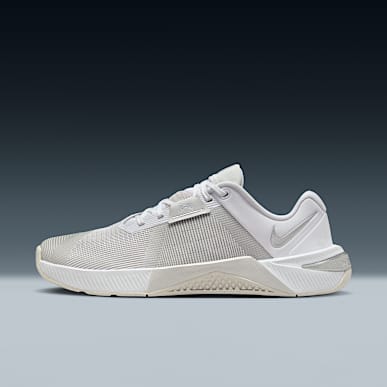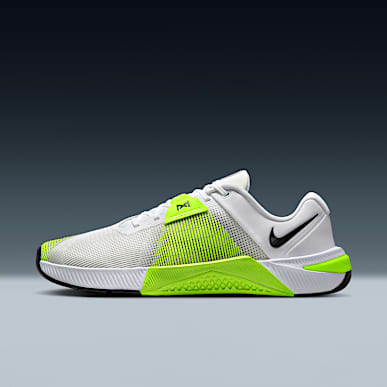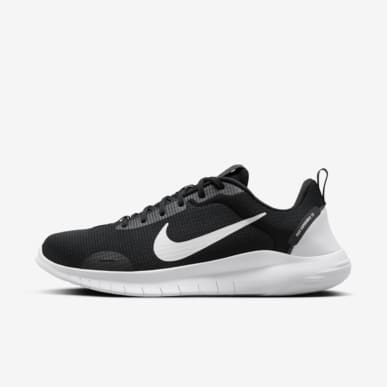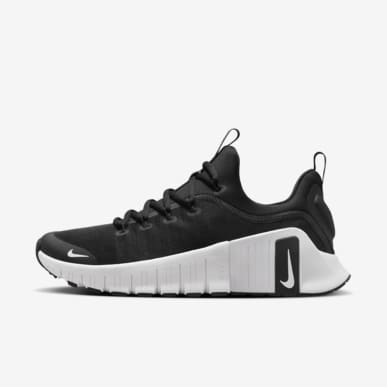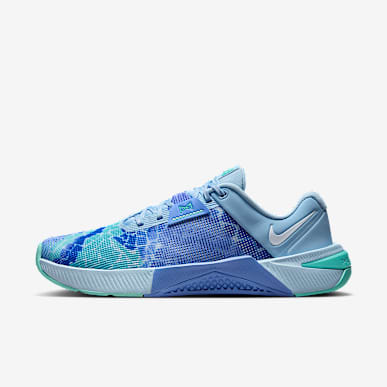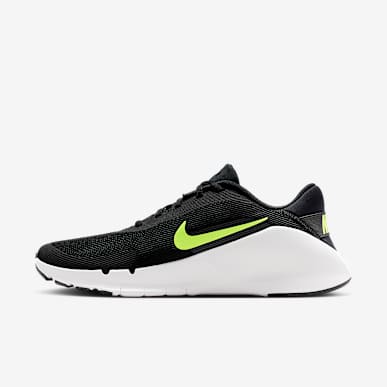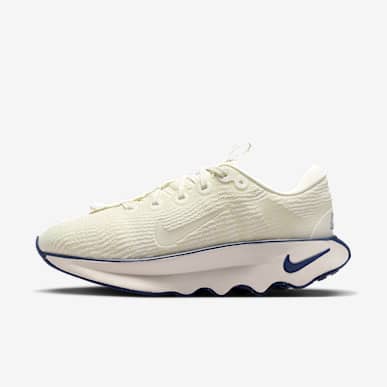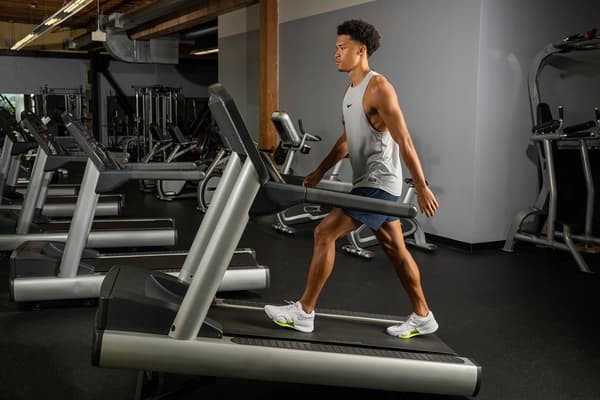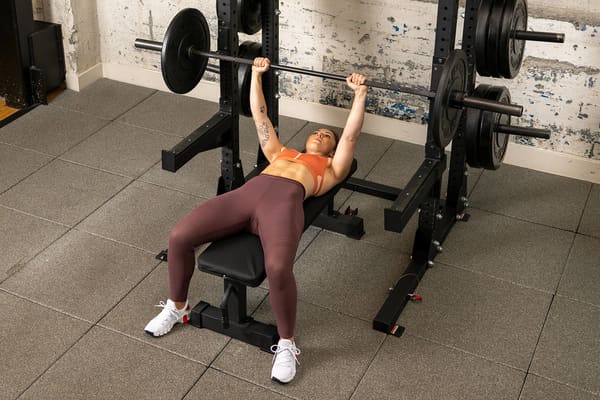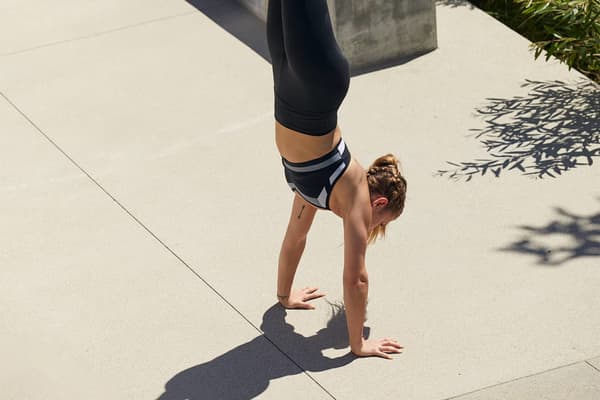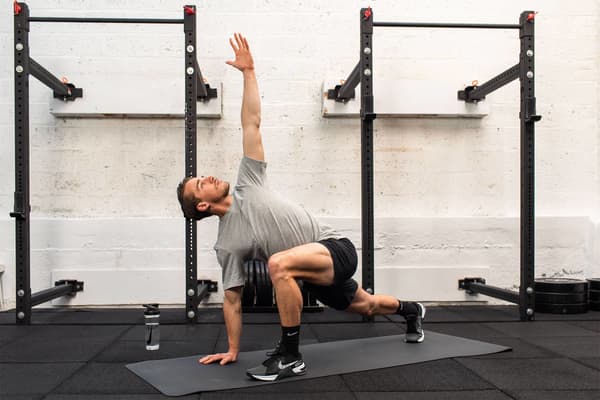The Top Bodyweight Workout To Do in Your Hotel Room
Sport & Activity
All you need for this 30-minute HIIT blast is space to move and a bit of motivation.

Anyone who's lugged a 23kg suitcase up a non-working airport escalator can tell you that travelling can be a workout. Jet lag and general travel fatigue have been proven to zap energy levels.
And while there's no shame in pausing workouts during travel, getting your heart pumping has some energy-boosting benefits. A 2017 study found that short bursts of activity—even for as little as 10 minutes—can help improve focus and alertness when travel-related fatigue and jet lag hit.
And you don't even need to leave your hotel room to get your sweat on. Research from the International Journal of Exercise Science found that bodyweight training—or training that uses gravity, rather than an external load like dumbbells—can have cardiovascular and strength benefits.
Try this no-equipment hotel room workout routine from Albert Matheny, NSCA-certified strength coach.
The Ultimate 30-Minute Bodyweight Hotel Room Workout
Equipment needed: none
Fitness level: all (use modifications listed below)
Time commitment: 25 to 30 minutes, depending on the length of rest between sets and exercises
Warm-up: 2 to 5 minutes
Walkouts
- Stand with your feet hip-width apart, your arms by your sides.
- Crouch slightly to bring both palms to the floor. Using the hands to support the body's weight as it shifts forwards, slowly start to walk them out in front until the body is horizontal in a straight-arm plank position. This means that palms are firmly planted into the ground, shoulders are in line with the wrists, heels are pushing towards the back of the room and gaze is just beyond the fingertips. Engage the core while holding for one to two seconds.
- Slowly begin to walk the hands back to the feet and assume a crouch position. Move back to a standing position. Repeat two to three times.
World's Greatest Stretch
- Lower the body into a lunge with the left foot in front, facing forwards, and the right foot planted into the ground, heel slightly raised off the floor. Place your hands on the floor so they're parallel with the left foot. The left hand should be on the right side of the left foot.
- Continuing to plant the left palm into the ground for support, slowly twist the torso to the right while drawing the right hand directly upwards. Keep your eyes on the right hand as it moves towards the ceiling.
- Take two to three deep breaths in, exhaling out slowly with each one. With each breath, attempt to twist the torso a tiny bit further to the right. Switch sides. Repeat two to three times.
Bodyweight Workout: 25 to 28 minutes
For the moves below, rest for 30 to 60 seconds (or as long as needed) before moving from one exercise to the next.
1.Reverse Lunges
Muscles worked: glutes, hamstrings, quads, calves
Why it's beneficial: In addition to being a great all-round leg strengthener, Matheny said that reverse lunges are a unilateral movement, which adds in an extra balance and coordination challenge.
How to:
- Stand with feet hip-width apart, arms by sides and placed on hips or in a "runner's stride" (so elbows are bent and one arm is in front of the torso and one arm behind it).
- Keeping the core engaged, step the right foot backwards as the left knee lowers into a lunge. The right heel should be slightly lifted off the ground while the left knee extends just beyond the left toes. The torso should lean forwards slightly.
- Using the left leg's hamstring, quad and glutes to power the movement, step the right leg forwards to a standing position.
- Pause, then repeat eight to 12 times. Switch legs. Perform two to three sets on each leg, resting for 30 to 60 seconds between sets.
2.Single-Leg Hip Bridges
Muscles worked: hamstrings, glutes, core muscles
Why it's beneficial: For travellers who've spent the majority of the day in an aeroplane or car seat, a single-leg hip Bridge can help to open those cramped, tight hips, Matheny said.How to:
- Lie on the back with your hands by your sides, palms facing the floor. Bend your knees so your feet are roughly 15cm from the buttocks.
- Pressing your palms firmly into the floor, raise the hips off the floor as much as is comfortable. The chin should feel as though it's squeezing into the chest but not uncomfortably so. Squeeze the glutes. This is Bridge position.
- From Bridge position, extend the left knee into the air so the left leg is straight. Slowly, and with control, lower the hips to the floor, using the arms (with palms pressed down) to stabilise the body. Once barely touching the ground, squeeze the glutes and tighten the core to drive the hips back upwards, keeping the left leg extended the entire time.
- Repeat eight to 12 times. Switch legs. Perform two to three sets on each leg, resting for 30 to 60 seconds between sets.
Make it easier: omit step three, executing Bridge pose eight to 12 times.
Make it harder: instead of lying flat on the back, position the shoulder blades on the edge of a chair or bed so the torso is lifted more vertically. You can also place a heavy object (for example, a large book) on the lap when lifting the hips.
3.Push-Ups
Muscles worked: chest, core muscles, triceps, biceps, shoulders
Why it's beneficial: Targeting a wide range of muscles in the upper body at once, there's a reason why push-ups are a bodyweight superstar, said Matheny. Plus, they can be scaled up or down to maximise or minimise challenges.
How to:
- Get on all fours and plant the palms firmly on the ground. Hands should be in line with the shoulders.
- Simultaneously straighten the arms and legs, pushing the legs behind you, to move into a straight-arm plank position. Legs should be straight and the feet should be hip-width apart.
- Bracing the core, begin to bend the elbows directly behind you (although it's fine to allow them to push to the sides slightly) slowly and with control. Keep the gaze slightly ahead. Once the chest nearly touches the floor, pause, then push through the palms to move back into a straight-arm plank.
- Repeat 10 to 15 times. Perform two to three sets, resting for 30 to 60 seconds between sets.
Make it easier: perform a wall push-up. Start the movement by standing roughly 30 to 60cm from a wall or as far back as needed so that the arms are fully extended when the palms are pressed into the wall. To perform the movement, use the same form cues above (i.e. brace the core through the descent, pause once the chest nearly touches the wall, then push through the palms to extend the arms).
Make it harder: elevate the feet on a chair or bed while keeping the hands on the ground. Use the same form cues above (i.e. brace the core through the descent, pause once the chest nearly touches the floor, then push through the palms to extend the arms).
4.Crab Walks
Muscles worked: triceps, core muscles, shoulders, glutes, hamstrings
Why it's beneficial: Matheny said that tightness in the chest and forearms—a symptom often brought on by long bouts of sitting at a computer—can be remedied with this move.
How to:
- Sit on the ground with knees bent and hands behind the torso, palms pressed into the floor and fingers pointed away from the torso (either directly behind or slightly flared out to the side, depending on wrist flexibility).
- Continuing to press the palms into the floor for support, lift the hips roughly 5 to 8cm off the ground. Gaze should be neutral. This is crab position.
- Keeping the core still and buttocks lifted, move the left foot and right hand forwards at the same time, then quickly repeat that pattern with the right foot and left hand. Repeat the motion to move the body forwards and reverse the motion (so the left foot steps backwards as the right hand moves backwards) to move the body backwards.
- Repeat step three for roughly 20 to 30 seconds or as long as is possible. Rest for 30 seconds, then repeat two to three more times.
Make it easier: Hold the "crab position" static and don't move in any direction.
Make it harder: Pick up the speed of the crab walk or continue the movement for as long as possible.
5.Burpees
Muscles worked: core muscles, triceps, biceps, shoulders, glutes, hamstrings, quads, calves Why it's beneficial: Despite their (sometimes) negative reputation, "Burpees are a great full-body conditioning movement", Matheny said. "You can make it easier or more difficult as you need to match your current fitness level".
How to:
- Stand with your feet hip-width apart, your arms by your sides. Bend the knees and push the hips back until the hamstrings are parallel (or almost parallel) to the floor. Bend the torso forwards slightly and plant the hands on the floor directly in front of the feet.
- Using the hands to support the body, jump the feet back (softly and with control) directly behind you. The body should form a straight-arm plank position, with the gaze just above the fingertips and core braced.
- With control, bend the elbows directly behind you to bring the chest to the floor. Once the chest nearly touches the floor, push through the palms to move back into a straight-arm plank.
- From a straight-arm plank, ensure the palms are planted firmly into the ground, then jump the feet forwards so they are just behind the hands.
- Using the glutes and hamstrings to drive momentum, push through the heels to explode rapidly upwards to a standing, then jumping, position.
- Land softly, then move directly into a squat motion, repeating the movement 10 to 20 times. Rest as needed to complete the workout. (*NOTE: Steps four, five and six should be executed in a single, swift motion. )
Make it easier: Matheny said that, as a burpee has so many moving parts, it's perfectly fine to remove one or multiple points. Cut out the push-up or vertical jump, or simply walk the feet to the back and the front instead of "jumping" them.
Make it harder: Moving through more reps or moving faster can add extra intensity.
Cool-down: 2 to 5 minutes
Knees-to-Chest Pose
- Lie on the back with your arms extended to either side. Take two to three deep breaths, exhaling slowly.
- On the second or third exhale, reach both arms towards the ceiling to draw both of the knees into the chest. Clasp the hands around the knees. (If not possible, grasp a towel in either hand to extend your reach.)
- Use the hands to draw the knees towards the chest. Gaze towards the ceiling while drawing the shoulder blades tightly into the ground, with the back of the head planted firmly into the ground. Inhale, then exhale, continuing to draw the knees as tightly into the chest as is comfortable. Inhale and exhale again three to four times.
- Rest and repeat as desired.
Child's Pose
- Get on all fours with knees slightly wider than hip-width apart. Touch the toes from each foot together. Palms should be shoulder-width apart and pressed into the floor.
- Sink the hips back slowly, keeping the toes together. Simultaneously, walk the palms out in front until the arms are fully extended while the hips are sunk back. Continue to press the palms into the floor.
- Inhale, then exhale deeply, continuing to drive the hips back. Try to keep the back as flat as possible, gazing towards the floor.
- Hold for 20 to 30 seconds. Rest and repeat as desired.
Words by Julia Sullivan, ACE CPT
